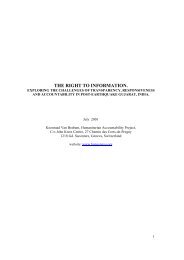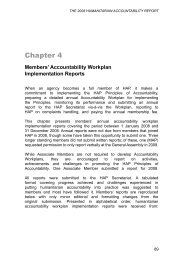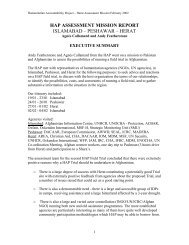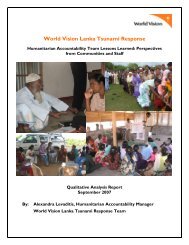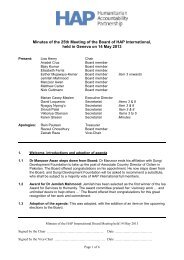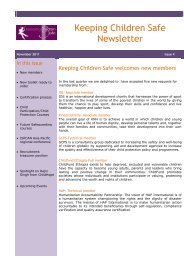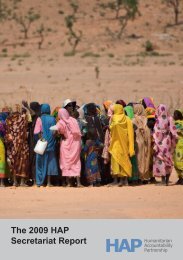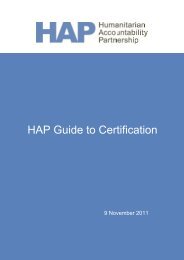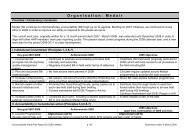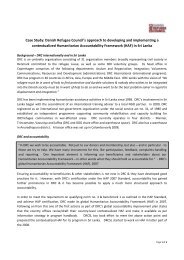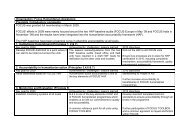A Case Study of Bangladesh (2008) - HAP International
A Case Study of Bangladesh (2008) - HAP International
A Case Study of Bangladesh (2008) - HAP International
Create successful ePaper yourself
Turn your PDF publications into a flip-book with our unique Google optimized e-Paper software.
<strong>HAP</strong> initiatives in Concern Worldwide: A <strong>Case</strong> <strong>Study</strong> <strong>of</strong> <strong>Bangladesh</strong> (<strong>2008</strong>)<br />
(This case study was compiled by Md. Abu Hanif, Monitoring and Evaluation Expert for Concern Worldwide<br />
<strong>Bangladesh</strong>. If you would like more information please email abu.hanif@concern.net)<br />
1. CYCLONE SIDR<br />
Cyclone Sidr, a category 4 cyclone, made land fall in the southern and central coastal belts <strong>of</strong> <strong>Bangladesh</strong><br />
on 15th November 2007. The cyclone affected 30 out <strong>of</strong> 64 districts mostly in the southern part <strong>of</strong> the<br />
country. More than 3,400 people were killed, 55,000 people injured and over 2 million families were made<br />
homeless. The financial cost <strong>of</strong> the disaster was estimated at $1.7 billion. The consequence <strong>of</strong> Sidr was<br />
mainly felt through the destruction <strong>of</strong> housing and loss <strong>of</strong> livelihoods (including agriculture crop production,<br />
assets such as fishing boats and nets, and other business).<br />
A few national NGOs (including BRAC, Grameen Bank, ASA and Proshika) had been working in the affected<br />
areas prior to the cyclone, mainly focused on micr<strong>of</strong>inance and education, and a few had experience <strong>of</strong><br />
disaster management. Following the cyclone international and national NGOs launched relief operations in<br />
the most-affected districts. Concern Worldwide <strong>Bangladesh</strong> was one <strong>of</strong> the international organizations that<br />
extended their operations to <strong>of</strong>fer relief support in the affected areas.<br />
Concern provided support to Sidr-affected areas through three local Partners; SPEED Trust, SHANGRAM<br />
and Dhaka Ahsania Mission. These three Partners had experience <strong>of</strong> implementing emergency response<br />
and rehabilitation programmes in other parts <strong>of</strong> <strong>Bangladesh</strong>. Both SPEED Trust and SHANGRAM are based<br />
in Sidr affected areas, and were already Partners <strong>of</strong> Concern Worldwide <strong>Bangladesh</strong>.<br />
Concern provided financial and technical support to the Partners for implementing the emergency and<br />
rehabilitation project. One Concern staff was appointed to each partner’s project to provide the technical<br />
support for ensuring quality services.<br />
2. RATIONALE FOR STRENGTHENING ACCOUNTABILITY<br />
Concern’s strategy in <strong>Bangladesh</strong> is to work with the poorest and most vulnerable people, supporting them<br />
to improve their livelihood security, develop coping mechanisms to deal with natural disasters, improve their<br />
health and nutritional status, and access education facilities. Therefore, disaster preparedness, mitigation<br />
and management is one the focus areas.<br />
Concern undertook the Sidr relief and rehabilitation project considering the vulnerable situation and based<br />
on the problems identified in consultation with the affected population in target communities. A number <strong>of</strong><br />
factors contributed to the drive to strengthen accountability as part <strong>of</strong> this response:<br />
The extent <strong>of</strong> the damage forced all organizations to undertake large responses, and therefore most felt<br />
challenged to ensure quality <strong>of</strong> the work. It was felt that being vigilant <strong>of</strong> the <strong>HAP</strong> Standard would help<br />
the organization to ensure the quality <strong>of</strong> its work.<br />
The organizational commitment to meet the <strong>HAP</strong> Standards (as part <strong>of</strong> Concern’s obligation as a <strong>HAP</strong><br />
Member) and the realization <strong>of</strong> the links between the <strong>HAP</strong> Standard and Concern’s mission and vision.<br />
The findings <strong>of</strong> the accountability self-assessment (see below).<br />
3. THE ACCOUNTABILITY SELF-ASSESSMENT<br />
In February <strong>2008</strong>, Concern Worldwide <strong>Bangladesh</strong> worked with <strong>HAP</strong> to carry out a self-assessment on<br />
humanitarian accountability and quality management using the <strong>HAP</strong> Standard at one project area where<br />
Concern was responding to Cyclone Sidr. During the self-assessment particular focus was given to how<br />
information was shared with affected-communities; through what methods affected-communities were able to<br />
participate in project decision-making; and what mechanisms existed for affected-communities to raise<br />
complaints and receive a response. Through this much good practice was identified as well as a number <strong>of</strong><br />
gaps including:<br />
<br />
Partner staff was not aware <strong>of</strong> the humanitarian Principles <strong>of</strong> Accountability or the <strong>HAP</strong> Standard.<br />
Page 1 <strong>of</strong> 8
Community participation in project designing and beneficiary selection was almost missing because it<br />
was done mainly through a survey method.<br />
Community people didn’t know the selection criteria, which <strong>of</strong>ten caused doubts amongst them about<br />
Concern and the Partners.<br />
There was a lack <strong>of</strong> information disseminated to affected-communities on the project implementation<br />
process and status updates. Information was only disseminated during house visits and at distribution<br />
centres on the day <strong>of</strong> distribution.<br />
There were no formal complaints handling mechanism or procedure.<br />
4. PILOTING NEW APPROACHES<br />
To address the gaps identified as part <strong>of</strong> the self-assessment Concern undertook a series <strong>of</strong> activities<br />
focused on their Sir and flooding emergency response and rehabilitation projects. Many <strong>of</strong> the activities<br />
involved trailing new approaches, which were refined throughout and Concern is now looking to review, learn<br />
and improve on this practice. Some <strong>of</strong> the highlights based on activities trailed from March to November<br />
<strong>2008</strong> are described below:<br />
a) Ensuring Partner Involvement<br />
It was felt that in order for this initiative to become grounded in the humanitarian approach Partner capacity<br />
and involvement had to be ensured. From April-May <strong>2008</strong>, Concern in <strong>Bangladesh</strong> organised two batches<br />
training for Partner and Concern Project staff exploring the <strong>HAP</strong> Principles, humanitarian accountability<br />
benchmarks and the <strong>HAP</strong> Standard. Particular attention was given to benchmark five, which focuses on<br />
Complaint and Response Mechanisms. An additional training was organized before starting a new project<br />
and oriented Partner field level staff as well as management staff. In total these trainings covered more than<br />
200 staff from Concern and six Partner organizations.<br />
Example <strong>of</strong> the contents covered as part <strong>of</strong> an orientation<br />
session on <strong>HAP</strong> Standard with Concern and partner<br />
project-staff:<br />
• What is <strong>HAP</strong>?<br />
• <strong>HAP</strong> Principles and Benchmarks?<br />
• Downward accountability?<br />
• Complaint Mechanism and its principle and<br />
system development procedure and processes?<br />
• Participatory beneficiary selection techniques<br />
(Priority ranking, matrix ranking and Pair wise<br />
ranking)?<br />
• What should be incorporated into the upcoming<br />
flood response programme?<br />
• What Concern has already done (sharing our<br />
success and some case studies)<br />
• Next action plan?<br />
Training with Concern and Partner staff<br />
Page 2 <strong>of</strong> 8
) Exploring ways to increase community participation in beneficiaries’ selection<br />
As part <strong>of</strong> the training on <strong>HAP</strong>, facilitated by Concern Worldwide <strong>Bangladesh</strong>, Partners and Concern project<br />
staff jointly developed a participatory beneficiary selection process. Previously the beneficiary selection<br />
criteria had been identified by the Partners based on their own understanding, and the beneficiary list<br />
developed by discussions with individual household family members during house-to-house visit. The new<br />
beneficiary selection process centred around the community themselves identifying the selection criteria, and<br />
developing the beneficiary list based on this. The new process is summarised in the following diagram:<br />
1. Village selection:<br />
Information collected during a transit walk is<br />
summarised using the ‘Village Pr<strong>of</strong>ile Format’. A wellbeing<br />
analysis is then done to select the village.<br />
.<br />
2. Beneficiary selection criteria development:<br />
Through a group meeting the beneficiary selection<br />
criteria are developed. Emphasis is given to<br />
ensure all types <strong>of</strong> community representation<br />
during this meeting Poor and extreme poor,<br />
women, disabled and children are highly<br />
encouraged.<br />
6. Sharing the final beneficiary list:<br />
After validation the final beneficiaries list is written<br />
on poster paper, signed by the participants who<br />
developed the list (those who are unable to write<br />
request others to add their name), and is hung in a<br />
public place (normally on the wall <strong>of</strong> a house) at<br />
community level as per decision by the community<br />
people who participated in the process. The<br />
community then uses this displayed list as a check<br />
during the distribution process.<br />
5. Validation <strong>of</strong> the beneficiary list:<br />
House-to-house visits are then conducted to<br />
validate and finalize the list <strong>of</strong> project beneficiaries.<br />
Validation is carried out by PNGO staff alongside a<br />
number <strong>of</strong> community representatives.<br />
All level community representatives share their views<br />
Validation <strong>of</strong> priority list visiting house to house<br />
3. Vulnerable households identified:<br />
The community people analyse the well being <strong>of</strong><br />
households and their vulnerability. Based on this a<br />
list <strong>of</strong> vulnerable households in the village are<br />
identified.<br />
4. Priority list preparation:<br />
The community people use Pair Wise Preference /<br />
Priority Ranking or Matrix Ranking to identify the<br />
eligible beneficiaries.<br />
Community people prepare a priority beneficiaries list<br />
Results <strong>of</strong> priority ranking list are presented by the<br />
community<br />
The process, along with supporting tools for implementation, was documented to guide Partner staff and was<br />
used from October <strong>2008</strong>.<br />
Page 3 <strong>of</strong> 8
Initial results<br />
Between October and November <strong>2008</strong> a total <strong>of</strong> 6,372 beneficiaries were selected using this approach as<br />
part <strong>of</strong> both Sidr and flood response programmes.<br />
Based on experience this participatory beneficiary selection process takes more than three hours to<br />
complete, but received positive feedback from community participants who had the opportunity to discuss<br />
several issues during priority listing. The community people are happier with this process and share their<br />
views with the visitors to the project.<br />
While most <strong>of</strong> the community participants spoke easily as the process was related to their own and local<br />
issues, strong staff facilitation skills are needed to ensure the effectiveness <strong>of</strong> this process. Due to limited<br />
resources it is challenging to reach conclusions and agreement on the final (limited) list with the community<br />
participation. In addition during the process some <strong>of</strong> the more influential community people try to take the<br />
lead, and influence the list base on their preferences.<br />
Initially there was some resistance from the Partners to adopt a more participatory approach to identifying<br />
beneficiaries. Some <strong>of</strong> the Partners had development projects in the affected areas, and intended to give<br />
support to their ‘group members’ (beneficiaries from their development projects) following their traditional<br />
selection process. However, after implementing this process the partner staff expressed more positive views<br />
- that this process is a better way to select the beneficiaries as it is more transparent and as a result partner<br />
staff received fewer complaints from the community about the biasness <strong>of</strong> the list. As the community<br />
decided who is the most vulnerable, services were given on a priority basis.<br />
c) Establishing Community Monitoring Committees (CMCs) and piloting a complaints handling<br />
mechanism<br />
The <strong>HAP</strong> training was used to orientate Partner staff in establishing a complaints mechanism, seek<br />
commitment from Partner’s Executive Directors, and designed plans to establish a complaint and response<br />
mechanism. While the Community Monitoring Committees (CMCs) and the complaint and response<br />
mechanism are still being developed and strengthened based on learning to date, the following outlines key<br />
elements established as <strong>of</strong> November <strong>2008</strong> and the initial results observed.<br />
Complaint submission (see diagram over the page)<br />
The following channels were provided for affected-communities to submit a complaint:<br />
Complaints boxes - in total 24 were set up in each production or distribution centre, and were managed<br />
by the Upazila Community Monitoring Committee.<br />
Mobile phone - three mobile numbers were disseminated (the focal person for Complaint handling, the<br />
Partner Project Coordinator, and Field Coordinator <strong>of</strong> Concern Worldwide, <strong>Bangladesh</strong>).<br />
Face-to-face - to one <strong>of</strong> the Union Community Monitoring Committee members, or Partner or Concern<br />
staff during a field visit.<br />
Different submission means were used, via different people, to enable community members to raise<br />
complaints about harassment, fraud or misconduct from staff if needed.<br />
Complaint processing (see diagram over the page)<br />
The documents <strong>of</strong> all complaints received were kept in a register, alongside what actions had been taken<br />
and the status <strong>of</strong> each complaint. Complaints received via the Upazila or Union CMCs were either reviewed<br />
and responded to directly by these committees, or referred up to the next level.<br />
Community Monitoring Committees (CMCs) – role in monitoring and complaint handling<br />
Community Monitoring Committees (CMCs) with 5-7 members were formed at two different administrative<br />
levels with the aim <strong>of</strong> monitoring the quality <strong>of</strong> project work at a local level, and providing one avenue for<br />
beneficiaries and community people to raise complaints. Both Upazila and Union CMCs defined their role<br />
and responsibilities at their inception, and documented these in the meeting register. In total 7 Upazila and<br />
31 Union level CMCs were formed and began functioning by the 4 th phase in April <strong>2008</strong>. The table below<br />
summarises the composition <strong>of</strong> the CMCs and their main activities:<br />
Page 4 <strong>of</strong> 8
CMC members<br />
Activities<br />
Upazila level CMCs (sub-district)<br />
Formed by, and comprised <strong>of</strong>, Partner<br />
local staff, other NGO staff and local<br />
elites (e.g. teachers, businessmen).<br />
a) Reviewing the security and quality<br />
<strong>of</strong> supplied materials at production<br />
centres through fortnightly visits,<br />
and the quality <strong>of</strong> service <strong>of</strong> the<br />
rehabilitation project.<br />
b) Reviewing and responding to<br />
complaints submitted via the<br />
complaints box or complaints<br />
referred from the Union CMC.<br />
Union level CMCs (sub sub-district)<br />
Comprise <strong>of</strong> representatives from the project beneficiaries<br />
and local elites. The CMC members were selected in a<br />
participatory process by the local community people and<br />
project beneficiaries. For selection <strong>of</strong> members the following<br />
criteria were prioritised by the community:<br />
i. Availability and accessibility <strong>of</strong> the person<br />
ii. Ability to maintain confidentially<br />
iii. Credibility to people<br />
iv. Interest to give the time and take on the role.<br />
a) Monitoring the progress <strong>of</strong> the house carpenters,<br />
checking the quality <strong>of</strong> the materials and desired design<br />
<strong>of</strong> the work at community level. As they are from the<br />
same communist the Union CMCs visit the working<br />
places regularly.<br />
b) Receiving and responding to complaints received<br />
verbally and via monthly meetings. Complaints that<br />
cannot be dealt with are referred to the Upazila CMC, or<br />
Partner or Concern staff.<br />
A flow chart summarising the<br />
complaint and response<br />
mechanism trailed by<br />
Concern Worldwide in<br />
<strong>Bangladesh</strong><br />
The kinds <strong>of</strong> complaints that<br />
cannot be handled at field-level<br />
go up to senior manager level.<br />
Emergency Expert<br />
Concern Desk Officer,<br />
Dublin<br />
Organisational<br />
Report<br />
Share<br />
M&E Expert<br />
Based on this mechanism<br />
Concern staff are now refining<br />
how complaints are received<br />
processed and responded to (in<br />
particular looking at how more<br />
sensitive complaints can be<br />
handled) so that the<br />
mechanism is safe, accessible<br />
and effective for users.<br />
Key – modes for complaint<br />
submission:<br />
Report<br />
Field Coordinator <strong>of</strong><br />
Concern Project<br />
Report<br />
Head <strong>of</strong> PNGOs<br />
Concern and Partner project<br />
staff at Upazila level<br />
= complaint box<br />
= mobile phone<br />
CMC at Upazila<br />
level<br />
Refer complaints<br />
Refer<br />
complaints<br />
= face to face<br />
Complaints Review and<br />
Response<br />
CMC at Union level<br />
Review, investigate<br />
and solve ‘normal’<br />
complaints<br />
Participants/Beneficiaries/Community people<br />
Page 5 <strong>of</strong> 8
Initial results<br />
Complaints data - From last August to December <strong>2008</strong> 157 complaints were received in Sidr and Flood<br />
response areas. Of these 12% were received via the complaints box, 50% via mobile, and 38% via face-t<strong>of</strong>ace.<br />
It was found that many <strong>of</strong> the complaints received via the box were applications for aid, and the<br />
majority <strong>of</strong> the phone calls received were asking for information. Raising complaints directly with staff<br />
became popular, as it was easy, direct and did not require writing skills. In addition this channel also<br />
reassured the complainant that their complaint was being heard. As a result <strong>of</strong> the complaints received via<br />
the complaints box four staff were transferred, one staff member was dismissed, and seven beneficiaries<br />
were changed.<br />
Initial challenges in complaint handling - community people and beneficiaries started to make complaints,<br />
and request information, via mobile phone at late night (in particularly during Ramadan). As a result the<br />
Partner staff started to orient the community people on complaints issues, when they can make complaints,<br />
what issues they should consider as complaints etc., and the number <strong>of</strong> late night calls were reduced.<br />
In addition anonymous complaints, and those involving different types <strong>of</strong> conflict <strong>of</strong> interests, were<br />
challenging to investigate. A number <strong>of</strong> complaints were not substantiated, and active roles <strong>of</strong> the CMC<br />
members at field level helped in resolving the problem.<br />
Upazila CMCs - as a result <strong>of</strong> the production site visits the Upazila CMCs have influenced vendors,<br />
carpenters and others suppliers to replace low quality housing materials, and to re-build sub-standard<br />
houses. While initially the Partner did not consider including project beneficiaries as part <strong>of</strong> this group, but<br />
they are now trying to include them. Based on experience some <strong>of</strong> the Upazila CMCs were more active,<br />
giving time as needed, where as others were less active as their members were busy with their personal<br />
jobs. One <strong>of</strong> the challenges faced was with some <strong>of</strong> the elites asked for support due to their role as CMC<br />
members.<br />
Union CMCs - between April and December<br />
<strong>2008</strong> Union CMCs organised 39 meetings, and<br />
received complaints related to requests for aid<br />
and project quality. A number <strong>of</strong> challenges<br />
were experienced with Union CMC members<br />
exploiting their positions to extract bribes from<br />
the beneficiaries. This highlights the need to<br />
ensure committee members are carefully<br />
selected, and there is transparency over their<br />
role and expected behaviour (as well as a<br />
channel for people to raise concerns) in order to<br />
avoid creating another power structure.<br />
Learning from this experience was applied to the<br />
next rehabilitation and flood response project.<br />
Community Monitoring Committee members share their activities<br />
over the last month<br />
5. NEXT STEPS<br />
The next steps are to further develop and embed these approaches in Concern Worldwide, <strong>Bangladesh</strong> and<br />
include:<br />
Forming a core team for taking this forward, and developing an action plan.<br />
Reviewing the existing complaint and response mechanism with beneficiaries and staff, and using these<br />
findings to develop the mechanism further.<br />
Orienting staff and beneficiaries on the complaint and response mechanism.<br />
Integrating complaint and response mechanism issues into project M&E systems.<br />
6. FACILITATING FACTORS<br />
Financial and human resources<br />
The financial and human resource support from the organization was a major contributing factor for the<br />
success. The financial support included all phase’s training for Partner and Concern staff, capacity building<br />
for beneficiaries, system development, follow-up visit, and printing <strong>of</strong> information materials.<br />
Most important factor was the allocation <strong>of</strong> time to design the project in line with the <strong>HAP</strong> Standard, and the<br />
assignment <strong>of</strong> a focal person for focusing on <strong>HAP</strong> at country level. In addition specific responsibilities<br />
related to accountability and quality management were incorporated into staff job descriptions.<br />
Page 6 <strong>of</strong> 8
Budgetary allocation and adequate planning for strengthening accountability at project as well as<br />
organizational level is very much needed. This will allow for the development <strong>of</strong> systems, linkage and<br />
networking with other organizations including <strong>HAP</strong> Members, and exposure and learning visits.<br />
Commitment <strong>of</strong> senior management and staff input<br />
The continued follow-up from Concern Dublin <strong>of</strong>fice, <strong>Bangladesh</strong> Country Director and Assistant Country<br />
Director, as well as input from the HR Quality team; M&E, Right Based Approach (RBA) and Emergency<br />
team, Concern and Partner emergency project staff contributed to the progress made. Involvement <strong>of</strong> higher<br />
management to provide strategic support will remain an important factor for continuous improvements in<br />
maintaining organisational standards.<br />
7. CHALLENGES OVERCOME<br />
Working with Partners - Establishing downward and horizontal accountability across different levels is a key<br />
part <strong>of</strong> the <strong>HAP</strong> initiative, but it is challenging to develop common understanding on this with Partners. The<br />
Partners do welcome this concept after gaining experience, although there were long and difficult<br />
discussions for taking it to field level. Some Partners were disinterested to follow the participatory targeting<br />
process and to establish a complaint and response mechanism, fearing the potential conflict these<br />
approaches may cause. The trainings helped overcome this as they created a forum where they were able to<br />
develop a plan in conjunction with other Partners and Concern.<br />
Not integrated from the beginning - It is also challenging to incorporate the Principles <strong>of</strong> Accountability in the<br />
middle <strong>of</strong> project implementation; particularly during an emergency response that demands quick delivery <strong>of</strong><br />
services at large scale. It will be more effective if the organization takes steps to integrate during the project<br />
design stage, and to orient staff before implementing the project. Without proper orientation and mind setting<br />
on the <strong>HAP</strong> Standard it is difficult to succeed with moving forward.<br />
8. RESULTS OBSERVED AND LEARNING<br />
Community level<br />
Community engagement in these processes increased overtime along with community acceptance and<br />
trust in the implementing Partners.<br />
Beneficiaries’ selection by community participation, using participatory tools, was very powerful in<br />
ensuring people’s participation and as a result more people were satisfied with the beneficiary selection<br />
process.<br />
The biases <strong>of</strong> other stakeholders in influencing the selection process, in particular influencing the<br />
selection <strong>of</strong> certain people, gradually reduced.<br />
The Community Monitoring Committee’s function strengthened the check and control <strong>of</strong> quality <strong>of</strong><br />
services against the expected standards.<br />
The presence <strong>of</strong> staff relatives in the CMCs created conflict, and has potential for a few members to<br />
dominate. This learning was applied in next phase, when any relatives <strong>of</strong> staff were excluded as a CMC<br />
member.<br />
Staff<br />
The increased capacity <strong>of</strong> Partner staff on <strong>HAP</strong> Principles <strong>of</strong> Accountability and the <strong>HAP</strong> Standard has<br />
made them more open to ensuring downward accountability and setting standards <strong>of</strong> attitude and<br />
behaviour.<br />
Increased confidence among staff in involving community people to select the project beneficiaries<br />
following a participatory process.<br />
The complaint and response mechanism led to changes in staff attitudes, increasing the closeness and<br />
accountability <strong>of</strong> the staff.<br />
Organisational<br />
As a result <strong>of</strong> being sensitized on downward accountability the Concern <strong>Bangladesh</strong> Programme Quality<br />
Unit, which falls under the Learning and Sharing Department, has developed a specific objective related<br />
to establishing and promoting downward accountability at programme level. It is envisaged this will also<br />
contribute to the overall image <strong>of</strong> the organization.<br />
2009 budget allocation includes funding for the M&E Unit to develop staff capacity on the Principles <strong>of</strong><br />
Accountability and <strong>HAP</strong> Standard.<br />
Page 7 <strong>of</strong> 8
Feedback from donors (ECHO, DIPECHO) based on project visits also was very appreciative <strong>of</strong> the <strong>HAP</strong><br />
progress and initiatives. They appreciated the targeting and Complaint and Response Mechanism (both<br />
establishing complaint boxes and CMCs at union level).<br />
9. CONCLUSION<br />
Based on the learning and experiences <strong>of</strong> Concern Worldwide, <strong>Bangladesh</strong>, we would recommend others to<br />
apply the participatory tools for selecting beneficiaries, and form CMCs at community level as an approach to<br />
promote humanitarian accountability during an emergency response and rehabilitation.<br />
Page 8 <strong>of</strong> 8




